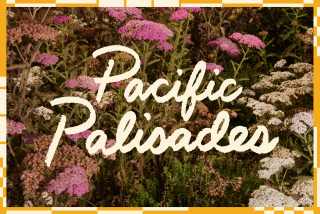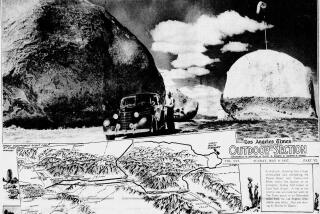Colorful Greek Isle of Crete Is Where Legend Meets Life
Even with the maddening overlap of legend and history, just about anyone--from dedicated archeologist to rank amateur--can make a strong case for this Aegean island of Crete being the steppingstone that allowed Egyptian art and civilization to cross the Mediterranean to mainland Greece, thence onward to all of the Western World.
From about 6000 BC right up to the antics of native son Zorba the Greek, Crete has had enough colorful characters and events to fill a library of encyclopedias, with most of the legends beginning about 1900 BC when the Palace of Minos (three miles south of Heraklion at Knossos) was probably built.
King Minos had a craftsman named Daedalus who, among other things, built the infamous Labyrinth of Minos beneath the palace. Roaming the labyrinth was the monstrous Minotaur (Minos bull)--a half-man, half-bull that was another of Daedalus’ doings.
It seems that King Minos’ lusty wife had Daedalus fashion a hollow bronze cow for her. She then hid in the cow, and her union with a bull produced the Minotaur of Greek legend, a monster that was periodically fed seven maidens and seven young men to sate his horrendous appetite.
Whatever the verities of these and other Minoan legends, the palace itself has been documented, thanks to the renowned British archeologist Sir Arthur Evans, who in 1900 began to excavate and rebuild the site. His work, and that of others who followed, has resulted in one of the most beautiful and remarkable attractions in the Aegean.
Crete is the Aegean’s largest island, some 160 miles long and anywhere from 7 to 30 miles wide. The capital of Heraklion is awash in visitors throughout the summer months, its harbor jammed with cruise ships. Yet somehow the town manages to absorb the hordes, probably because many head straight for Knossos and the palace.
From one end of the island to the other finds reminders of its conquerors through the centuries (Moors, Turks, Venetians and Germans of World War II). Unlike some of the smaller and more popular islands (Mykonos, Santorini, Hydra), the beachside and interior towns and villages are given added color by natives who still wear the traditional Cretan costumes daily.
The small beach at Heraklion is hardly one to get excited about, but just outside town in either direction lie lovely strands calling sun-and-water worshipers. And the entire island is rimmed with enough small villages and beaches, woodsy coves and tiny harbors to satisfy anyone with a yen to get away from it all.
How long/how much? Give the town and palace at least a full day, perhaps more for scouting about the island. Lodging costs continue to climb toward expensive in Greece. Excellent dining is always a great bargain anywhere in the country.
Getting settled in: For years we have been staying in Xenia hotels (Greece’s largest chain) and have always found them first-rate operations without being luxurious. This one fits the mold perfectly, a contemporary building right on the water (not much of a beach, but there’s also a pool). Furnishings are modern, there’s a small bar, and the restaurant is adequate but nothing special. Yet the price is certainly right, and Xenia also has hotels on Crete in Chania, Rethymno and Carteros.
The Atlantis, a family oriented hotel near town center, has a lot going for it: room balconies overlooking the sea, rooftop pool and cafe, large dining room, bar and tennis courts across the street. The lobby and rooms are very contemporary, and the Atlantis is just a short walk from Liberty Square and the marvelous Archeological Museum.
A new one since our last visit is the very handsome Galaxy, with just about anything available one would find in a big-city, class-A hotel. It’s built around a pool and garden, with inside or terrace dining, neat bedrooms all done in light pine. The Galaxy is Heraklion’s pride and rightly so.
Regional food and drink: Crete has the seafood that one finds throughout the Greek isles: cuttlefish and octopus hot off the charcoal grill; fangri , a delectable fish found only in the eastern Mediterranean; plenty of calamari (squid), and the delicious and devilish little barbouni , a red mullet with enough tiny bones for a fish 10 times its size.
Meat dishes lean toward the souvlakia (kebabs) of lamb, beef or veal on a spit with onions, tomatoes and bell peppers. And the keftedakia (small meat balls) are to cry over. Then there is always the old standby of moussaka (layers of eggplant, ground beef and lamb, tomatoes, grated cheese and oregano) served with a bechamel sauce.
All Greek meals start with mezes (appetizers), and three of the best are thick “dips”: taramosalata , made of red fish roe, mashed potatoes, olive oil and lemon; scordalia (almost pure garlic mixed with mashed potatoes), and our favorite, tzatziki , a heavenly mix of cucumbers, yogurt, garlic and oil.
Crete has wonderful red and rose wines, but no Greek meal goes well with us (particularly seafood) without a cold carafe of white retsina, so named for the resin flavor. But be advised that it’s definitely an acquired taste.
Dining well: Drop right into the local scene with a lunch or dinner at To Sokati (Merabelous St. 25, at the foot of the hill by the city tourist office). This tiny taverna is as typical as one can get, with a tiny patio beneath a reed shelter, few tables and blue tablecloths across the 10-foot-wide street from the kitchen. Waiters scurry back and forth with superb seafood and souvlakia--wonderful Greek salads of cucumber, tomatoes, onions, black olives, feta cheese and oregano flooded with olive oil.
Costa’s Taverna (Dedalou 6) is on a pedestrians-only street chockablock with shops, cafes and restaurants. This one opens onto the street, where there are also tables, and was run by the original Costa for 40 years. Try the fangri here, or maybe the roast lamb juvetsi , served with a rice-shaped pasta laced with Greek herbs.
Klemataria (Dedalou 8) is nearby and equally typical of a small Greek taverna. Owner Manolis Doxastakis oversees every dish that comes from the kitchen and then double-checks by asking patrons their opinion of the food. He’s a jovial type, anxious that everyone leaves as happy as he is.
On your own: Just as with the Acropolis in Athens, it’s a good idea to visit Knossos and the palace as early in the morning as possible, before the tour buses arrive and the sun takes on a nasty bite. Pick up a plan of the palace and work your way through at leisure, taking care not to miss the Royal Apartments, or the craftsmen workshops with a formidable display of huge terra-cotta amphoras. This same vessel design turns up in the former colonies of Magna Grecia (southern Italy and Sicily in the 8th Century BC). Give the palace an absolute minimum of two hours.
The Archeological Museum in town holds a glorious collection of the Minoan civilization: pottery; small faience vases and statues of priestesses unearthed at Knossos, and numerous artifacts, jewelry, mosaics and murals, including those of the topless maidens who ran toward charging bulls, grasped their horns and flipped themselves over the bulls’ backs. The museum is a fascinating place to spend an hour or so.
Have a strong Greek coffee at a cafe on Liberty Square or along Dedalou Street, then consider a walk around Paleo Limani (the 13th-Century Venetian “Old Port”). A clutch of seafood tavernas is in the area.
GUIDEBOOK
Crete
Getting here: Fly Pan Am, TWA, KLM, British Airways or Alitalia to Athens, then Olympic Airways on to Heraklion. An advance-purchase, round-trip ticket to Athens will cost between $1,494 and $1,544. It’s $66 each way from Athens to Heraklion.
Fast facts: Greece’s drachma recently sold for 190 to the dollar, about .005 each. Visit anytime between spring and late fall.
Settling in: Hotel Xenia (Sof. Venizelou 2, $47 double B&B;); Atlantis (Merambellou St. 6, $58 double B&B;); Galaxy (Dimokratias 67, $65 double B&B;).
For more information: Call the Greek National Tourist Organization at (213) 626-6696, or write (611 West 6th St., Suite 2198, Los Angeles 90017) for a brochure on Crete with map and sights, another map of all Greece.
More to Read
Sign up for The Wild
We’ll help you find the best places to hike, bike and run, as well as the perfect silent spots for meditation and yoga.
You may occasionally receive promotional content from the Los Angeles Times.






